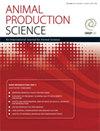Replacing bacitracin zinc antibiotic with symbiotic additive in pullet diet
IF 1.2
4区 农林科学
Q2 Agricultural and Biological Sciences
引用次数: 0
Abstract
Context Currently, since the use of antibiotics as growth promoters in animals has been banned worldwide, it is necessary to use other additives that indorse an adequate balance of the intestinal microbiota, so as to render better results in nutrient acquisitionand health of poultry, yielding adequate growth and performance.Aim The study evaluated the effects of dietary supplementation with symbiotics during the grower phase, to replace bacitracin zinc.Methods The experiment included a total of 684 pullets of the Dekalb White strain, from 6 to 15weeks of age, distributed in a completely randomised design, with five treatments, and eight replications of 18 birds each. The treatments were composed of two base diets, namely one of corn and soybean meal (reference diet, RD), and another of meat and bone meal (MBM), in addition to two more diets based on MBM, one with an addition of 0.05% of bacitracin zinc (Bac Zn), and the other with 0.1% of symbiotic provided to two groups, including one group that had already consumed the symbiotic since the first day of life (starter phase, Symb-S), and the other that started to consume at the beginning of the experiment (grower phase, Symb-G). Performance, blood variables, nutrient metabolisability, weights of organs of the immune and digestive system, and measurement of length (intestine and caecum) were determined. Data were compared using orthogonal contrast.Key results The birds fed with the RD diet presented a worse overall performance and coefficients of apparent metabolisability of dry matter (CAMDM) (6–10weeks) than did those fed the MBM diet. Birds fed with the Bac Zn diet showed better bodyweight gain (6–15weeks), coefficients of apparent metabolisability of gross energy (CAMGE) and CAMDM (6–10weeks) than did those fed the MBM diet. Birds fed with symbiotic diets had better responses in blood biochemistry variables (alkaline phosphatase, total proteins) than did those fed the Bac Zn diet.Conclusion The use of symbiotics since the starter and grower phase can replace the use of Bac Zn, without affecting the biochemical and metabolic responses of the pullets.Implications Symbiotics improved utilisation of diet nutrients, maintenance of physiological homeostasis, and growth of pullets.共生添加剂替代菌肽锌抗生素在蛋鸡饲粮中的应用
目前,由于世界范围内禁止在动物中使用抗生素作为生长促进剂,因此有必要使用其他添加剂,以保证肠道微生物群的适当平衡,从而在家禽的营养获取和健康方面取得更好的结果,从而获得适当的生长和生产性能。目的评价在育成期饲粮中添加共生菌素替代杆菌肽锌的效果。方法选用6 ~ 15周龄的白鸡雏鸡684只,采用完全随机设计,5个处理,8个重复,每个重复18只。试验由玉米豆粕(参考日粮,RD)和肉骨粉(MBM)两种基础日粮组成,另外两种以MBM为基础的日粮,一种添加0.05%的杆菌肽锌(Bac Zn),另一种添加0.1%的共生菌素,提供给两组,其中一组从出生第一天起就已经食用共生菌素(发酵期,Symb-S)。另一种在实验开始时开始消耗(生长阶段,符号b- g)。测定生产性能、血液指标、营养物质代谢率、免疫和消化系统各器官重量以及长度(肠和盲肠)。采用正交对比法对数据进行比较。试验结果:RD饲粮在6 ~ 10周的综合生产性能和干物质表观代谢系数均低于MBM饲粮。Bac Zn饲粮的增重(6 ~ 15周)、总能表观代谢率(CAMGE)和总能表观代谢率(CAMDM)(6 ~ 10周)均优于MBM饲粮。共生饲粮对血液生化指标(碱性磷酸酶、总蛋白)的反应优于Bac Zn饲粮。结论从发育期和生长期开始施用共生菌制剂可以代替Bac Zn的使用,且不影响仔鸡的生化和代谢反应。共生体改善了饲料营养物质的利用,维持了生理平衡,促进了幼崽的生长。
本文章由计算机程序翻译,如有差异,请以英文原文为准。
求助全文
约1分钟内获得全文
求助全文
来源期刊

Animal Production Science
Agricultural and Biological Sciences-Food Science
CiteScore
3.00
自引率
7.10%
发文量
139
审稿时长
3-8 weeks
期刊介绍:
Research papers in Animal Production Science focus on improving livestock and food production, and on the social and economic issues that influence primary producers. The journal (formerly known as Australian Journal of Experimental Agriculture) is predominantly concerned with domesticated animals (beef cattle, dairy cows, sheep, pigs, goats and poultry); however, contributions on horses and wild animals may be published where relevant.
Animal Production Science is published with the endorsement of the Commonwealth Scientific and Industrial Research Organisation (CSIRO) and the Australian Academy of Science.
 求助内容:
求助内容: 应助结果提醒方式:
应助结果提醒方式:


